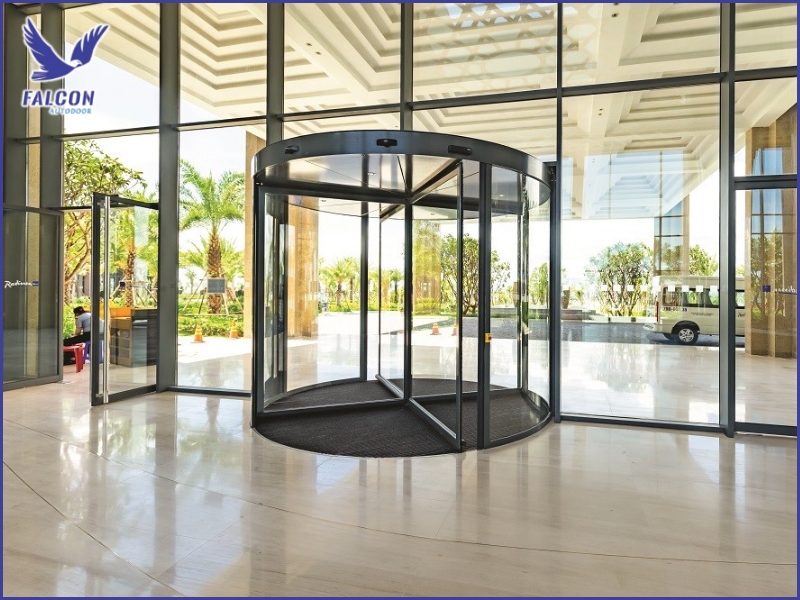Comparison of modern automatic door sensor technologies
Sensors play a crucial role in determining how well an automatic door operates, as they detect movement and ensure safety during use. Each type of sensor is based on different technology, offering distinct advantages and limitations. Let’s explore and compare them with Thuy Linh Long in the section below.
1. The importance of sensors in modern automatic door systems
Sensors are the core component in an automatic door system, allowing the door to detect when a person or object moves within the scanning area and trigger the opening and closing process. Thanks to sensors, doors function accurately, safely, and with improved energy efficiency especially in environments with high foot traffic such as office buildings, supermarkets, and hospitals.
1.1 The function of sensors in automatic doors
Sensors detect physical activity such as motion, distance, or heat changes and send these signals to the central controller, which activates the door motor. This fully automated interaction allows users to pass through without physical contact. The result is a smooth, hands-free experience that enhances convenience and accessibility in shared public spaces.
1.2 The role of sensors in ensuring safety and saving energy
Besides opening the door when someone approaches, sensors also prevent the door from closing if a person or object is still in the path. This reduces the risk of collision and injury. Additionally, sensors only activate when necessary, decreasing unnecessary door operation. This reduces wear on the motor system, cuts electricity consumption, and extends the service lifespan of the door mechanism.

2. Common automatic door sensor technologies today
Today’s automatic door industry offers multiple sensor technologies designed for different usage needs and environmental conditions. Each type varies in sensitivity, interference resistance, and operating range, which directly affects the overall performance of the door system.
2.1 Infrared sensor (IR sensor)
Infrared sensors detect changes in heat signatures within their scanning range. When a person enters the detection zone, the system signals the motor to open the door. This type of sensor is widely used indoors due to its stable and cost-effective performance. However, direct sunlight or high temperatures may cause interference, reducing accuracy. They are best suited for offices, residential complexes, restaurants, and hotel lobbies.
2.2 Microwave sensor
Microwave sensors operate using the Doppler effect, detecting motion based on frequency changes in reflected waves. They offer a wider detection range and faster response speed, making them ideal for busy entrances. However, they may trigger falsely in windy conditions or when lightweight objects move near the entrance. These sensors are commonly used in supermarkets, commercial centers, and public buildings with continuous foot traffic.
2.3 Hybrid sensor
Hybrid sensors combine microwave and infrared technology to improve detection accuracy and stability. By cross-checking readings from both methods, they minimize false activations and maintain performance regardless of weather conditions or lighting. Due to higher cost and more complex installation requirements, hybrid sensors are preferred in hospitals, airports, and premium corporate facilities where safety and reliability are critical.
2.4 Safety beam sensor
Safety beam sensors project an infrared beam across the doorway. If something interrupts the beam while the door is closing, the system stops or reopens the door. This prevents accidents such as trapped hands, strollers, carts, or equipment. Although installation requires precise beam alignment, this sensor type is essential in operating rooms, warehouse doors, garage entrances, and any environment requiring maximum safety.

3. Detailed comparison of common automatic door sensors
Different sensors vary in sensitivity, scanning range, interference resistance, cost, and durability. Evaluating these characteristics helps users select a solution that meets practical requirements whether prioritizing speed, accuracy, safety, or overall operational cost.
|
Criteria |
Infrared Sensor |
Microwave Sensor |
Hybrid Sensor |
Safety Beam Sensor |
|
Operating principle |
Heat detection |
Doppler effect |
Combined wave analysis |
Infrared beam interruption |
|
Motion sensitivity |
Medium |
High |
Very high |
Auxiliary (closing phase) |
|
Detection range |
1–3 m |
2–6 m |
2–6 m |
0.5–1 m |
|
Interference resistance |
Medium |
Good |
Excellent |
Excellent |
|
Response time |
Moderate |
Fast |
Fast and precise |
Fast |
|
Investment cost |
Low |
Medium |
High |
Medium |
|
Durability |
Fair |
Good |
Excellent |
Very good |
|
Ideal applications |
Indoor / office |
High-traffic entrances |
Medical & industrial |
Safety-critical zones |

4. Emerging trends in automatic door sensor technology
As smart building systems advance, sensor technology continues developing beyond basic motion detection. New-generation sensors incorporate AI, IoT connectivity, and adaptive control systems that optimize performance based on user behavior, energy efficiency goals, and real-time safety requirements.
4.1 AI-enhanced recognition sensors
Artificial intelligence allows sensors to distinguish between humans, vehicles, and objects, filtering out unnecessary triggers. This reduces accidental door activations, minimizes mechanical wear, and improves overall safety performance especially in high-security environments.
4.2 IoT-connected sensor systems
With IoT connectivity, building managers can monitor door activity remotely, track real-time data, and receive maintenance alerts. Automatic updates and integrated control dashboards improve efficiency in large-scale facility management, such as multi-tower buildings and smart campuses.
4.3 Energy-saving and eco-adaptive sensors
Energy-efficient sensors automatically adjust sensitivity based on traffic density and ambient conditions. They only activate when required, reducing electricity usage and component stress. This contributes to sustainable building practices and longer operational life.

Sensors are the foundation that determines the safety, efficiency, and durability of automatic doors. Let Thuy Linh Long support you in choosing and installing the right sensor solution, ensuring smooth performance and professional building operation. Contact us today for full consultation and a tailored solution package.
THUY LINH LONG SERVICES TRADING COMPANY LIMITED
DISTRIBUTOR
Address: 243D Vuon Lai Street, Phu Tho Hoa Ward, Tan Phu District,
Ho Chi Minh City, Vietnam.
Tel: +84 28 22497999
E-mail: cuatudong24h@gmail.com
SUPPLIER
KUM YANG MATERIALS CO.,LTD
Address: 124-60, Myeongdong-ro, Hallim-myeon,
Gimhae-si, Gyeongsangnam-do, 50851, Korea.
Tel: 82-55-345-8380










